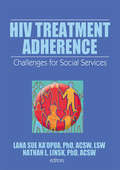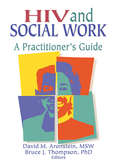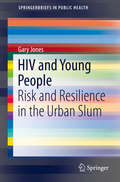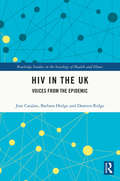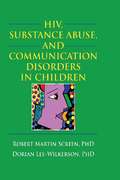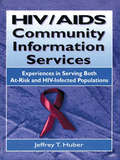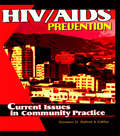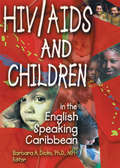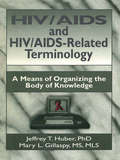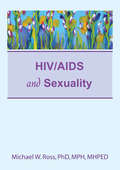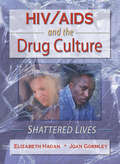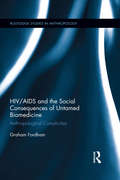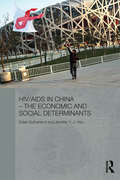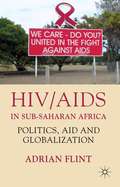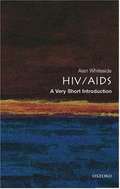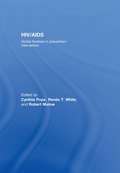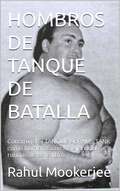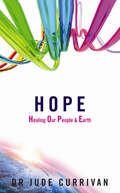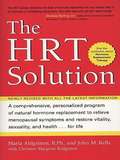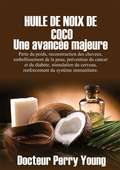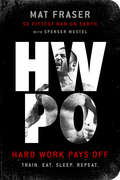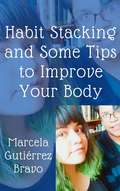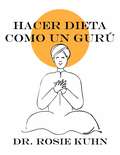- Table View
- List View
HIV Treatment Adherence: Challenges for Social Services
by Lana Sue Ka’opua Nathan L. LinskLearn the latest social service interventions to promote HIV medication adherenceHighly Active Antiretroviral Therapy (HAART) can significantly improve the health outcomes of people living with HIV. Still, benefits rely on the steady adherence to the medication regimen as prescribed. Social Work and HIV: Challenges to Treatment Adherence is a practice-friendly resource with the latest HIV medication client adherence strategies and guidelines. This valuable book provides the tools for assessment of client adherence, and includes approaches and helpful guidelines to develop specialized counseling, social services, and provider training programs. Treatment plans for HIV can be complicated and client adherence can hinge on several diverse factors. Social Work and HIV: Challenges to Treatment Adherence explains in detail how professionals can help individuals with HIV to stick to the prescribed medication plan. This book focuses on the daunting psychosocial, spiritual, and biomedical challenges that social workers, social service professionals, and healthcare providers often encounter and provides strategies to effectively address these issues. Innovations in adherence counseling and provider training programs are explored. Practitioners will learn psychosocial interventions that are empirically based, with predictors of adherence closely examined on how they may vary by gender, socioeconomic, and ethnocultural diversity. Co-occurring health and behavioral conditions, such as substance use, are considered in detail. Chapters are extensively referenced and several have tables and figures to clearly present data.Topics in Social Work and HIV: Challenges to Treatment Adherence include: key themes within current treatment adherence research from the 2006 NIMH/IAPAC International Conference on HIV Treatment Adherence reviews of studies of psychosocial predictors of HAART among HIV positive clients research on the impact of support from partners, family, and health care providers has on medication adherence factors that predict medication adherence among HIV positive adults research on the differential effects of social and religious support and background variables on treatment adherence interventions to improve HAART adherence in methadone clinics specialized adherence counselors and their impact on adherence training to increase counselor knowledge of HIV medications, adherence strategies, and improved counseling skills studies on the prevalence of continued drug use and everyday adherence decision making Social Work and HIV: Challenges to Treatment Adherence is a valuable resource for social workers; substance abuse counselors; social service and other health care providers; researchers; educators; and policy advocates. The book is also a relevant supplemental text for graduate courses in counseling; multi-systems interventions; community health; social development practice; research methods; and program evaluation as offered through departments of social work, public health, nursing, health psychology, community medicine, and interdisciplinary health professional training programs.
HIV and Social Work: A Practitioner's Guide
by R Dennis Shelby David M Aronstein Bruce J ThompsonAs HIV/AIDS continue to plague societies around the world, more and more social workers encounter HIV-infected individuals and their families and friends who are searching for help and support. In HIV and Social Work: A Practitioner's Guide, experienced social workers share their practice wisdom, knowledge, and skills on a broad range of issues. Their words of wisdom will give you the willingness to follow problems through and the flexibility and creativity that are required when dealing with issues concerning HIV/AIDS. At the same time, you will achieve a sense of empowerment and optimism as you realize that there are things you can do--very specific kinds of help you can offer--that can make an enormous difference in the lives of people with HIV/AIDS and those who love and care for them. HIV and Social Work is a practical, user-friendly resource for social workers who practice in a variety of settings and fields. You'll find it a rich and useful book if you're moving into HIV/AIDS work and want guidance, or if you're experienced and want to sharpen your skills, or if you just want to be prepared for when you find people with HIV or their family members in your office in need of help. Specifically, you'll gain valuable insight about:basic psychosocial interventions for people with HIV/AIDSin-depth practical suggestions for specific problem areas and specific groups of people with HIV/AIDS better listening skillshow to know your own limitations and live your own life more fully in the face of sadnessthe importance and challenge of returning to fundamental social work skillsYou'll refer to HIV and Social Work time and time again as you confront new HIV-related situations in your practice for which you need easy-to-understand descriptions of what to do and how to do it. Acknowledging your busy schedule, the book is organized so that you may use it on a “knowledge as needed” basis or read it straight through. Written specifically by and for social workers, HIV and Social Work is highly recommended as required reading in social work programs at the Bachelor's and/or Master's levels.
HIV and Young People
by Gary JonesRevisiting the thinking on vulnerability to HIV and risk of infection, this book provides better understanding by considering the risk of HIV infection alongside notions of personal and collective resilience, dignity and humiliation. The work shows that young people in the urban slum dignify their world and, in doing so, establish priorities and draw on a set of references oftentimes intelligible to them alone. Moreover, humiliation, as an interpersonal event, adds to a sense of vulnerability and lies closely behind choices directly affecting personal health and livelihood. Thus, dignity and humiliation are shown for the first time to have a critical role in health seeking and risky behavior related to HIV, and this is an area in great need of further research. The crucial focus of this work is further emphasized by the rapid growth of urban slums, and high rates of HIV among both slum dwellers and young people, who continue to bear the brunt of the AIDS epidemic, thirty years on. This comprehensive literature review provides a compelling argument that the time is right to further explore the nexus of risk and resilience from a people-centered perspective. Fresh insight is critical to reach the goal of ending AIDS by 2030.
HIV in the UK: Voices from the Epidemic
by Jose Catalan Damien Ridge Barbara HedgeThis book explores the thoroughly human dimension of the health care and prevention responses to the HIV crisis in the UK, and the impact that such initiatives had on the progression of the epidemic. This book presents a compelling account of the unfolding of the epidemic and the initiatives that made all the difference in the care and prevention of HIV in the UK from the early 1980s to the present time. Drawing on interviews with people with HIV, doctors and nurses involved in their care, leaders of AIDS charities, activists, and politicians, it identifies and describes the models of care developed in response to the onset of the HIV epidemic, and its impact on NHS and voluntary organizations. It goes on to explore the political responses, the evolution of HIV stigma, and the personal impact of the early high mortality rates. Finally, it discusses recent organizational changes in the provision of care and prevention services. In doing so, this volume identifies the lessons learnt from the care and prevention of HIV, both in relation to HIV infection and other conditions, such COVID-19, and discuss future challenges. This book will be of great value to those working in services dealing with HIV, charities, and CCGs and GP organizations, as well as social historians and medical sociologists.
HIV, Substance Abuse, and Communication Disorders in Children
by R. Dennis Shelby Robert M. ScreenMake sure every child gets a chance to be heardHIV, Substance Abuse and Communication Disorders in Children examines the language problems of young children from special populations. Essential as a textbook for graduate and upper-level undergraduate studies and as a reference resource, this unique book presents up-to-date research and compelling case studies that illustrate how prenatal exposure to drugs, alcohol, and HIV can affect a child in utero and continue to handicap its development after birth. Each chapter includes discussion threads and review questions to promote critical thinking and clinical problem-solving skills in the classroom.HIV, Substance Abuse and Communication Disorders in Children looks at the negative impact a mother&’s lifestyle practices can have on her developing child with a nod toward the significant prevalence of HIV and substance abuse in today&’s society. Some estimates place the number of infants born after prenatal exposure to illicit drugs as three-quarters of a million-every year. When alcohol is added, the figure rises to more than 1 million. This powerful book focuses specifically on the serious consequences of alcohol, marijuana, cocaine, and crack cocaine abuse, including poor language development and speech delays, limited vocabulary, the inability to make their needs known, poor articulation, the inability to follow commands, limited expressive language skills, and the inability to understand the real meaning of words and generalize them. And of the nearly 5,000 children in the United States living with AIDS, almost all will struggle with speech production and communication disorders as the disease affects their brain, spinal cord, and central nervous system. HIV, Substance Abuse and Communication Disorders in Children examines: the effect of drugs on the brain pregnancy and drug use trends common drugs of abuse Kosakoff&’s syndrome fetal alcohol syndrome (FAS) among Native Americans and African Americans neurologic sequellae speech and language intervention rehabilitation considerations treatment and family counseling and much moreHIV, Substance Abuse and Communication Disorders in Children is essential for graduate and undergraduate students working with language disorders in special populations.
HIV/AIDS Community Information Services: Experiences in Serving Both At-Risk and HIV-Infected Populations
by M Sandra Wood Jeffrey T HuberInformation forms the basis for education, and currently education is the only weapon available to stem the spread of HIV/AIDS and to foster empathy toward individuals already affected by the disease. HIV/AIDS and Community Information Services provides readers with insight into the information construct within the AIDS arena and how that construct affects the provision of information services to the HIV/AIDS affected population. It will serve as an irreplaceable reference as the number of individuals with AIDS increases, creating a greater demand for information and making that information increasingly difficult to provide.While directories exist to assist with practical approaches to accessing HIV/AIDS-related information, none had served as a comprehensive resource concerning the nature of that information or the provision of information services. HIV/AIDS Community Information Services fills that void. It fosters the enlightenment of the general public concerning the true nature of HIV/AIDS, guides readers in providing information services--both educational and recreational--to individuals affected by HIV/AIDS, and encourages the dissemination of instructional materials to those individuals at risk for infection. In doing so, contributors provide readers with information about: the relationship between AIDS and the body of information concerning the disease the complex nature of HIV/AIDS-related information available HIV/AIDS information services information as a means for empowerment suggestions for future programs, potential collaboration efforts, and innovative servicesAn essential guide for information professionals, librarians, health educators, counselors, members of community-based AIDS service organizations, and individuals affected by HIV/AIDS, HIV/AIDS Community Information Services foster the creation, accession, collection, organization, dissemination, and sharing of information concerning the HIV/AIDS epidemic and promotes the provision of services to individuals already affected by HIV/AIDS.
HIV/AIDS Prevention: A Guide for Working with People Who Are Blind or Visually Impaired
by Judy Matsuoka Christine E. Pawelski. Gaylen KappermanThis manual is designed to help rehabilitation teachers, educators, and other practitioners who work with blind and visually impaired persons provide their clients with the facts they need to deal with the issues concerning HIV/AIDS.
HIV/AIDS Prevention: Current Issues in Community Practice
by Doreen D. SalinaDevelop a positive working relationship between researchers and community groups focusing on HIV/AIDS prevention, and discover how to evaluate HIV/AIDS programs! An indispensable manual for everyone involved with HIV/AIDS research, prevention techniques, and the needs of individuals with HIV/AIDS, HIV/AIDS Prevention: Current Issues in Community Practice covers everything from the likelihood of condom usage by college women to the psychological effects on minority men infected with the HIV/AIDS virus. Essential reading for psychologists, research scientists who work with communities or who are involved in AIDS prevention programs, and for care takers of people with HIV/AIDS, Contemporary Topics in HIV/AIDS Prevention covers the necessary collaborative steps needed to create a positive researcher/community based organization (COB) partnership that will benefit researchers and those affected by the disease. In HIV/AIDS Prevention, you will examine many different models designed to effectively foster a positive researcher/CBO relationship while learning how to overcome problems you may encounter when researching a social issue or working with a researcher. This book also explains how and why many HIV prevention programs have been poorly evaluated due to a lack of funds and social politics. In addition, you will discover how you can obtain and/or perform a true evaluation of an HIV prevention program. In HIV/AIDS Prevention, you will explore many important issues and factors that help create successful programs, including: factors necessary for valid HIV/AIDS prevention program evaluations assessments of coping strategies, psychological variables, and the physical well-being of African- American and Latino men living with HIV/AIDS steps for the collaborative process between researchers and community groups making a good match between community-based organizations and researchersHIV/AIDS Prevention gives you pertinent information and guidelines for selecting a community-based organization to work with and the steps to creating a successful relationship. This book will give you the strategies and information you need in order to give pastoral support and prevention education to at-risk individuals. You will discover what is necessary for a true HIV/AIDS prevention program evaluation.
HIV/AIDS and Children in the English Speaking Caribbean
by Barbara A DicksExamine the biopsychosocial, environmental, spiritual, and policy issues that affect HIV/AIDS prevention/service delivery issues for Caribbean youth!This groundbreaking book provides an overview and informed discussion of HIV/AIDS as it affects children and adolescents in Antigua, Barbados, Grenada, Jamaica, and The Republic of Trinidad and Tobago. With contributions from noted HIV/AIDS experts in the region, it examines the biopsychosocial, environmental, spiritual, and policy issues that impact HIV/AIDS prevention/service delivery issues for Caribbean youth. HIV/AIDS and Children in the English Speaking Caribbean breaks the silence on this subject that has existed throughout the Caribbean--second only to Sub-Saharan Africa in terms of the number of people infected with the disease--by focusing attention on the issues, needs, perspectives, policies, and research that impact those affected by the epidemic in that region. This unique book gives special attention to the distinctive differences among Caribbean countries with varying customs based on colonial influences including language, culture, traditions, and religion. User-friendly tables and figures make the statistical information easy to understand.HIV/AIDS and Children in the English Speaking Caribbean discusses a diversity of topics, including: psycho-cultural issues and adolescents the impact of dance hall music on HIV and adolescents school programs evaluation of residential placements for children with AIDS sexual risk-taking behaviors of Jamaican street boys the inaugural lecture on AIDS at the University of the West Indies . . . and much more. Everyone whose professional life brings them into contact with this population, including social workers, psychologists, counselors, clinicians, nurses and other health care professionals, as well as educators and their students will find HIV/AIDS and Children in the English Speaking Caribbean a very useful resource for understanding the devastating impact of the HIV/AIDS virus on children and adolescents in that part of the world.
HIV/AIDS and HIV/AIDS-Related Terminology: A Means of Organizing the Body of Knowledge
by M Sandra Wood Jeffrey T Huber Mary L GillaspyHIV/AIDS and HIV/AIDS-Related Terminology: A Means of Organizing the Body of Knowledge offers an adaptable and extensive framework for organizing the ever-expanding number of resources on the HIV/AIDS epidemic. It lays down the groundwork upon which future blocks of information can be placed. As new information becomes available, it can be integrated into this system without rearranging the information already stored. This saves the time and money associated with revising a less flexible existing system. The book’s instructions for use and taxonomic classification system make it easy to use. HIV/AIDS and HIV/AIDS-Related Terminology is designed for use in any setting where HIV/AIDS healthcare or information services are provided. It acts as a guide to available resources and illustrates how to acquire the most up-to-date information. At the same time, it moves beyond the more general focus on the clinical, legal, and medical ramifications of HIV/AIDS to the development of an interdisciplinary cataloging system that includes all issues and topics associated with the disease. This invaluable reference tool leaves no rock unturned. It addresses every conceivable facet of the epidemic, from the psychological to the religious and from the economic to the social. Any organizations or institutions concerned with the collection, creation, management, and dissemination of HIV/AIDS-related materials will find this book an essential for their libraries. Practical and comprehensive, HIV/AIDS and HIV/AIDS-Related Terminology addresses a full range of topics, including: prevention and education epidemiology and transmission treatment funding opportunities health policy HIV/AIDS and the fine artsHIV/AIDS and HIV/AIDS-Related Terminology is the first book to provide a method for grappling with the vast scope of information on the HIV/AIDS epidemic. Its organic structure is designed to accommodate new knowledge as it becomes available, while it maximizes access to existing information in a variety of formats.
HIV/AIDS and Sexuality
by Michael W RossIn this important book, editor Michael Ross brings together the latest knowledge and research concerning the relationship between HIV and AIDS and sexual functioning. HIV/AIDS and Sexuality explores the experiences of being HIV-infected and the impact of infection on an individual's sexuality. It describes differences that may be associated with individuals who are infected or concerned about infection, and it provides new in-depth analyses of the effect of HIV on sexuality and sexual risks. The book provides clinical perspectives on sexual problems associated with HIV infection as well as some treatment approaches. Contributing authors represent the United States, Australia, and Europe and discuss heterosexual men and women, gay men, lesbians, and injecting drug users. This diversity provides a more complete picture of the experiences of people with HIV in terms of explicit and implicit sexuality. Chapters include cross-sectional and cohort study designs as well as qualitative, quantitative, and clinical approaches. Some of the topics explored are:the centrality of sexuality to equality of life and identity and the impact of HIV on sexuality in gay-identified menthe psychological impact of making changes in sexual behavior on gay men with HIV infectionrisk behaviors in seropositive and seronegative womena study of a cohort of HIV-infected women associated with the militarysexual addiction in gay men and its association with HIV risksovert and subtle communications processes that occur between health care providers and clients about sexuality and HIVstages of change in safer sexual practices in a cohort of gay menpersonality variables associated with risk and infection in both homosexual and heterosexual menHIV/AIDS and Sexuality opens up the area of sexuality in people living with HIV and focuses much-needed attention on the issues involved in sexual expression, HIV transmission risk, and living with HIV infection. This book is an illuminating exploration into the subject that helps professionals better understand their clients and thus provide more compassionate and effective care.
HIV/AIDS and the Drug Culture: Shattered Lives
by Joan Gormley Elizabeth HaganIn this startling new collection of case studies entitled HIV/AIDS and the Drug Culture: Shattered Lives, you‘ll take an eye-opening and informative look at the lifestyle and culture of the HIV/AIDS intravenous drug users (IVDUs). You‘ll see how health care providers and caregivers can update their methods and mindsets in order to meet the needs of
HIV/AIDS and the Social Consequences of Untamed Biomedicine: Anthropological Complicities (Routledge Studies in Anthropology #18)
by Graham FordhamDrawing on the case of HIV/AIDS in Thailand, this book examines how anthropological and other interpretative social science research has been utilized in modeling the AIDS epidemic, and in the design and implementation of interventions. It argues that much social science research has been complicit with the forces that generated the epidemic and with the social control agendas of the state, and that as such it has increased the weight of structural violence bearing upon the afflicted. The book also questions claims of Thai AIDS control success, arguing that these can only be made at the cost of excluding categories such as intravenous drug users, the incarcerated, and homosexuals, who continue to experience extraordinarily high levels of levels of HIV infection. Considered deviant and undeserving, these persons have deliberately been excluded from harm reduction programs. Overall, this work argues for the untapped potential of anthropological research in the health field, a confident anthropology rooted in ethnography and a critical reflexivity. Crucially, it argues that in context of interdisciplinary collaborations, anthropological research must refuse relegation to the status of an adjunct discipline, and must be free epistemologically and methodologically from the universalizing assumptions and practices of biomedicine.
HIV/AIDS in China - The Economic and Social Determinants: The Economic And Social Determinants (Routledge Contemporary China Series)
by Jennifer Y.J. Hsu Dylan SutherlandSouth and East Asia may well become the epicentres of the global HIV/AIDS pandemic. More than three-quarters of a million people are now estimated to be living with HIV/AIDS in China. In 2009, AIDS had already become the leading cause of death by infectious disease. Yet, even despite China’s recent economic and social progress, a number of development issues - not least the emergence of glaring inequalities - have also emerged. The expansion of the HIV/AIDS epidemic is also an important longer term development challenge. This book analyses China’s HIV/AIDS epidemic, with particular attention to the nature and impact of current economic and social changes and how these changes may be driving the epidemic. It examines aspects of income and gender inequality; rural-urban migration; commercial sex work; healthcare and civil society organizations. Health care reforms and the role of NGOs are also considered as well as general government policy. Overall, this book provides a full discussion of the most critical aspects of the current HIV/AIDS situation in China and its impact on Chinese society.
HIV/AIDS in Sub-Saharan Africa
by Adrian FlintThis book explains how issues of governance lie at the heart of understanding and combating the HIV/AIDS crisis in Africa. It reviews the debates surrounding the root causes of the pandemic and its continuing proliferation and examines the local and global socio-political forces that have contributed to the spread and impact of the disease.
HIV/AIDS: A Very Short Introduction
by Alan WhitesideHIV/AIDS is without doubt the worst epidemic to hit human kind since the Black Death. The first case was identified in 1981; by 2004 it was estimated that about 40 million people were living with the disease, and about 20 million had died. Despite rapid scientific advances there is still no cure and the drugs are expensive and toxic. Because of controversies and taboos surrounding safe drug usage and prostitution, the numbers of people infected continues to rise. However, it is in the developing world and especially parts of Africa that the real catastrophe is unfolding. In some of the worst affected countries life expectancy has plummeted to below 35 years, which has led to a serious decline in economic growth, a sharp rise in orphaning, and the imminent collapse of health care systems. The news is not all bleak though. There have been unprecedented breakthroughs in understanding diseases and developing drugs. Because the disease is so closely linked to sexual activity and drug use, the need to understand and change behaviour has caused us to reassess what it means to be human and how we should operate in the globalising world. This Very Short Introduction provides an introduction to the disease, the science, the international and local politics, the fascinating demographics, and the devastating consequences of the disease, and explores how we have responded and how we must respond in the future.
HIV/AIDS: Global Frontiers In Prevention/intervention
by Cynthia Pope Renee T. White Robert MalowHIV/AIDS: Global Frontiers in Prevention/Intervention provides a comprehensive overview of the global HIV/AIDS epidemic. The unique anthology addresses cutting-edge issues in HIV/AIDS research, policymaking, and advocacy. Key features include: · Nine original essays from leading scholars in public health, epidemiology, and social and behavioral sciences · Comprehensive information for individuals with varying degrees of knowledge, particularly regarding methodological and theoretical perspectives · A look into the future progression of HIV transmission and scholarly research HIV/AIDS: Global Frontiers in Prevention/Intervention is will serve as a precious resource as a textbook and reference for the university classroom, libraries, and researchers
HOMBROS DE TANQUE DE BATALLA: Construya el TANQUE ABRAMS TANK como hombros con los ejercicios y rutinas de este libro
by Rahul MookerjeeEstimado lector, La VERDADERA piedra angular de la fuerza de la parte superior del cuerpo de un hombre (o una mujer, para el caso) proviene de los HOMBROS. Hay una razón por la que tenemos el dicho "hombre de hombros anchos" en inglés y otros idiomas. Hay una razón por la que los hombros anchos, fuertes, densos y gigantescos no solo se ven poderosos, sino que SON poderosos, ¡e inspiran ASOMBRO a los ojos de los espectadores! ¿Y la razón? Bueno, simple... los HOMBROS son los que conectan toda la parte superior de tu cuerpo. En el pasado, los hombres, o debería decir HOMBRES DE VERDAD (pista: el hombre de hoy en día NO es lo que yo consideraría un hombre de verdad o en cualquier lugar cercano) ciertamente no pasó horas parloteando en la "estación de banco" más cercana o acicalándose y posando después de las "últimas relaciones públicas" con los hermanos. Hace mucho tiempo, cuando los HOMBRES eran REALMENTE fuertes, NO pasaban horas y horas tirando desesperadamente de uno de los inventos modernos más inútiles que existen; esa es la máquina de polea lateral: una invitación abierta a las lesiones, si alguna vez hubo una. Hace mucho tiempo, los HOMBRES DE VERDAD no se molestaban en tener seis paquetes, o secciones medias muy delgadas para "atrapar a las chicas" o "alardear en el spa". "(Oohh chico, ¿qué varonil, eh?) Se preocuparon por lo que era importante: desarrollar fuerza real, CARÁCTER real, ¡y hacerlo con energía, vigor y los ejercicios CORRECTOS! Combina eso con el desorden moderno de un hombre.
HOPE - Healing Our People & Earth: What You Can Do To Make A Difference...
by Jude CurrivanAs a cosmologist and healer, Dr Jude Currivan has journeyed to nearly seventy countries around the world and has explored and studied numerous important sacred sites and places of conflict. HOPE shares her understanding and experiences of the energetic connections between people and places from a spiritual perspective which is informed and expanded by leading edge science.HOPE investigates too how different groups and countries reflect and embody the same themes and issues that we experience on an individual human level. It reveals how the history of different areas of conflict around the world and our collective fear-based behaviours are based on traumas that we have energetically continued to resonate with - and crucially how to heal and release them. HOPE also shows the cosmic connection between astrological influences and the 'bigger picture' of what is unfolding, and explores why 2012 is so synchronistically destined to offer us the breakthrough of a shift of collective consciousness – if, as the Mayans say, we choose to do so!
HRT Solution (rev. edition): Optimizing Your Hormonal Potential
by Marla Ahlgrimm John M KellsNow revised and updated, the comprehensive program for restoring vitality, sexuality, and health using natural hormones-just the ones each individual woman needs, and just the amount she needs. The decision of whether or not to use hormone replacement therapy (HRT) during menopause is perhaps more controversial-and more confusing-than ever before. The HRT Solution provides a balanced discussion of the issues and, most important, offers a choice that goes beyond "yes" or "no." The authors explain the shortcomings of the conventional, "cookie-cutter" approach to HRT, which gives women standard-ized amounts of synthetic hormone substitutes or animal-derived hormone products. Instead, they recommend a program designed to meet each woman's particular needs. Their approach emphasizes the importance of testing and ongoing monitoring to determine precisely which hormones a woman may want to supplement. The solution lies in the prescription of individualized doses of custom-made natural hormones-exact matches for the ones a woman's body produces. The HRT Solution makes it possible for each woman to maintain a hormonal balance that is optimal for her body and her well-being, without the unpleasant side effects and potential for long-term health problems associated with conventional HRT. "The authors introduce a revolutionary new approach to hor- mone management that combines simple but precise testing to monitor hormone levels with personalized doses of natural hormones."
HUILE DE NOIX DE COCO: Une avancée majeure
by Perry Young Ngounou Takam CédricCe livre traite des bienfaits de l'huile de coco sur la santé. Après un bref historique sur l'huile de noix de coco nous avons le processus de fabrication d’huile de coco raffinée et l'huile de noix de coco vierge pure ainsi que la matière grasse contenue dans l'huile de noix de coco. Il aborde en outre, ses avantages sur pour les cheveux, la peau, dans la cuisine, pour perdre du poids, pour le cerveau. Enfin, cet ouvrage démontre l'éradication du cancer grâceà cette huile. . 10
HWPO: Hard Work Pays Off
by Mat Fraser Spenser MestelTransform your body and mind with the definitive guide to building peak strength, endurance, and speed, from the five-time CrossFit Games champion and Fittest Man on EarthNo matter your level of fitness, no matter if you&’ve never attempted CrossFit before, this book is your total training manual. Mat Fraser is undisputedly the fittest man in CrossFit history for winning the CrossFit Games an unprecedented five times. A student of engineering, Fraser optimized his body like a machine, and his absolute dedication to the training program he designed for himself is now legendary. For years, every single decision he made was weighed against the question: "Will this help me win?" If the answer was no, he didn't do it. If it would give him even the slightest edge or advantage, he would—no matter the cost. Fraser became a master of identifying his weaknesses and then seeking out training methods to improve them, and he's idolized in the fitness community for his relentless pursuit of peak performance. It's not hard to see why he achieved so much success—but how is a different question. Throughout his career, Fraser has been highly guarded about his specific training techniques (after all, sharing them would not help him win the CrossFit Games). But with his recent retirement from competition, Fraser is finally ready to open up about his path to the podium. HWPO reveals the workouts, training hacks, eating plans, and mental strategies that have helped make him a champion. It's an incredible resource of elite training strategies, illustrated workouts, and motivational stories, and it's a glimpse into the mind of one of the world's greatest athletes.
Habit Stacking and Some Tips to Improve Your Body
by Marcela Gutiérrez BravoThis book is a self-help tool that starts off with a guide to gain or break certain habits, and then move on to a collection of specific ideas on a certain topic in the second. The third, and final, section is a compilation of quotes that may serve as a status update for our social media accounts, or a reminder of our efforts.
Habitudes For The Journey: The Art of Navigating Transitions
by Tim ElmoreYou've probably already figured out that life is full of transitions---from middle school to high school; from high school to college or a job; from college to career. Each transition is an opportunity to establish great habits, make great choices and meet great people ... or an opportunity to absolutely fail at this. Some students aren't able to navigate the changes in their life and they get off track. Eventually they find themselves at a destination they don't like because they didn't make the right moves at the crucial times. This discussion guide was designed to prevent that. In fact, our goal is to help you get to where you want to go. At some point in the journey---you will face junctions, and must transition to a new place.
Hacer dieta como un gurú
by Dr Rosie KuhnCierto, los gurús no hacen dieta. Ellos no usan sustancias que cubran o adormezcan sus sufrimientos emocionales ni temores. Se fortalecen al observar sus emociones, pensamientos y sensaciones corporales de manera más profunda. Con sus mentes, descubren viejos esquemas de pensamientos y creencias que ya no tienen sentido, salvo dentro de la desconocida bóveda de las heridas. Nosotros no somos diferentes a cualquier otro gurú que yo conozca. Tienes las mismas habilidades para elegir según tus propias creencias y valores. Y todos los gurús empezaron igual que tú – dudosos, temerosos y renuentes al cambio. Ellos, como tú, decidieron que había algo más importante que adormecer, evitar, y distraer sus mentes de sus reales esencias y de las vidas que les fueron entregadas. Ellos, como tú, caminaron un paso a la vez, poniendo atención en lo que los llevó a tomar caminos de fracaso tantas veces. Vas a encontrar, al igual que esos gurús, que todos los momentos revelan tu más profunda valentía, convicción, fuerza y amor; ellos solo tuvieron que verlo y no huir de eso. Yo, como tú, como todos los gurús que conozco, puedo, y podré, elegir inevitablemente el amor. Sólo falta saber el “cuándo”.
